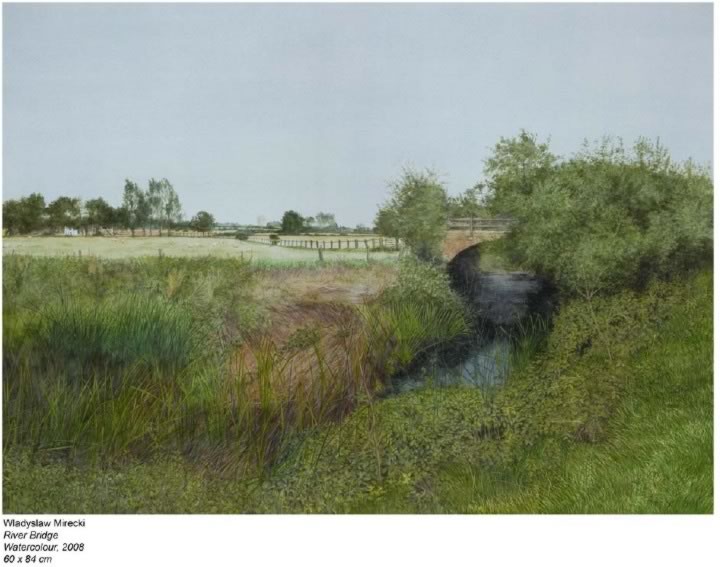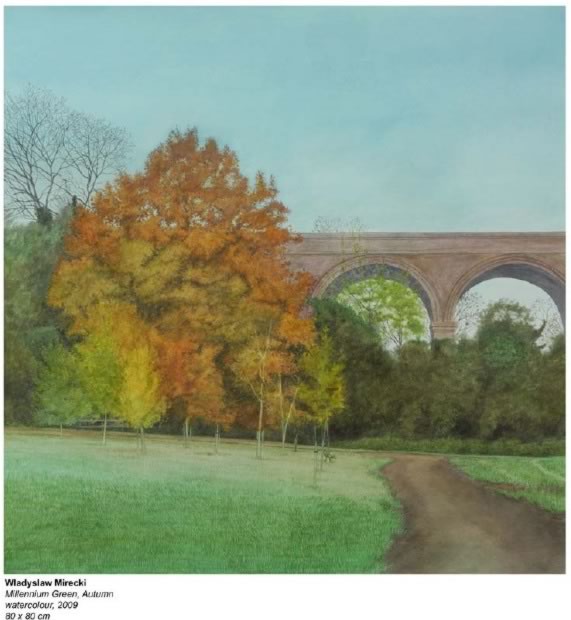WŁADYSŁAW MIRECKI
On My Doorstep
|
Private View Saturday 14th November
2009 noon - 5.00pm
Wine served - All Works for Sale
Exibition Finishes 6th December 2009 |
 |
Where enquiries of prices are
made on the gallery, the work is subject to availability
and the price to change.

"River Bridge" 2008 watercolour 60x84 cms
|
Władysław Mirecki
Landscape painting holds a special place in English hearts, perhaps because our love affair with the country began with the threat of its loss. It took the Industrial Revolution to open our eyes to the artistic possibilities of our native countryside. And as Satanic Mills sprouted and railways spread like fungus over our small island - conveniently ferrying urban artists into the country to paint - English painters finally found a comer of the foreign field of European art they could call their own.
By coincidence it was the railway, two centuries later; that brought Władysław Mirecki to the village of Chappel In rural Essex to work on the East Anglian Railway Museum. It was 1986, and he was recovering from a nervous breakdown brought on by abandoning a career in industrial design for art before deciding what sort of artist to be. In Chappel he met his wife Edna, who had opened the Chappel Galleries earlier that year; and found his subject in the local landscape: an unexceptional tract of rural England overshadowed by the Chappel Viaduct monumental relic of an industrial era when extravagant feats of engineering were squandered on the tail end of a branch line.
Despite his Polish name, Władysław 'Waj' Mirecki was born in England, and his work is steeped in the English landscape tradition. Visitors to this exhibition will find echoes of a wide range of 19th and 20th century English landscape painters:
John Nash in the rolling golden fields of After the Harvest; Eric Ravilious in the forbidding seaside prospect of Beach Hut Areas under Surveillance; Richard 'Dicky' Doyle (without his fairies) In the mysterious dusky depths of An Entrance to the Wood: Atkinson Grimshaw in the flare of foggy headlights through an arch in Misty Night with Viaduct; Gilbert Spencer in the bare winter oak silhouetted against the grey sky of Lone Rood, Wakes Colne; John Everett Millais in the minute botanical attention lavished on the luxuriant banks of sedge and nettles in Willow Form; and John Constable - a Favourite of Mirecki's - more or less everywhere.
But any resemblance to persons living or dead, as they say in film credits, is accidental: the style - or the studied absence of it - is the artist's own. Mirecki has an inherent suspicion of brushstrokes, 'happy accidents', and all those singular marks of individuality that sometimes smack of stylistic pretensions to Art with a capital 'A'. "One of the biggest handicaps to becoming a painter," he believes, "is this notion that one has to be an artist. Painting a straight picture isn't being 'artistic'."
If this sounds a little disingenuous, it is. Mirecki is not a camera, and although he uses one when planning his compositions, his ‘straight pictures’ are very far from photorealistic. The hours he spends in his studio hut in the garden coaxing his watercolour landscapes into life are devoted to an endless struggle not to produce straight copies of reality – relatively easy when you know how – but to permanently fix on a particular sheet of paper a particular visual image in his mind. He doesn’t like being described as a watercolourist because of the medium’s association with sketching; while others appreciate its gestural potential, he values its ability to blend in. His watercolours don’t sit on the surface of the paper, they become one with it. More than a vehicle of spontaneous, impromptu expression, a Mirecki watercolour is a considered, highly finished ‘thing’. Part of the viewer’s visual pleasure, on approaching close, is in the velvety surface of his vegetation. “I battle against the hard edges,” he confesses, “It’s nature out there.”
With the decline in respect for illusionism, painting is in danger of losing its magic: the primitive power to provoke childish delight at the sight of three dimensions rendered in two. Mirecki is a magician of the old school who believes that a painter's technique should be hidden. He has his secrets, such as collecting his watercolour slops and drying them into cakes or grey-brown sludge, a potion applied in the final wash, like fairy dust, to unify the warring parts of a picture. But despite his technical wizardry, he is not an 'old-fashioned' painter. His vision of landscape is neither Romantic nor neo-Romantic. The picture of England he presents is not bathed in nostalgia for a lost John Major-land of cricket, warm beer and old ladies cycling to church: the double yellow lines in the foreground of the prosaically titled Cold and Damp - a brumous view from the access road to the station car park- place us firmly in the present-day_ And while his meadows can occasionally come up buttercups, they can also be bone-chillingly bleak. Only someone living in an expatriate compound in Saudi Arabia could feel nostalgia for the wan brown sky of Country Lone, Winter or the frosted breath of the frozen field behind The Wire Fence.
Although no one paints a lusher bank of spring nettles or a crisper impression of AE Houseman's 'rusting harvest hedgerow', Mirecki prefers winter "because everything is revealed". Revelation is what his art is about, not in the visionary sense ¬Samuel Palmer is one English landscapist missing from his source book - but in the basic sense of drawing back the curtain of familiarity to reveal the everyday in a new light. It's to do with vision, pure and simple, "I don't make things up, you know," Mirecki says. Neither did Durer when he painted his Great Piece of Turf - everything about that clump of weeds is familiar and yet everything in our experience of the painting is fresh.
No one can second-guess the future of art - the ticks and mannerisms of our own age are too hard to spot - but my prediction is that Mireckj's style-free art will keep its freshness. Style dies back in time like summer vegetation, but the human eye never changes, and vision is timeless.
Laura Gasgoine |
WŁADYSŁAW MIRECKI
1956 Born Chelmsford, Essex of Polish parentage.
He is self-taught, having painted all his life including his periods gaining his
science degree, as an industrial designer and co-proprietor of Chappel
Galleries. |
|
|
EXHIBITED |
|
|
|
New English Art Club, Mall Galleries, London
|
|
Epping Forest District Museum “Artists in Essex”
Beecroft Art Gallery, Westcliffe on Sea, Essex 31st Open Exhibition
|
|
Chappel Galleries, Essex Solo Exhibition
|
|
Foyles Art Gallery, London
|
|
Department of Transport art Competition, Mall Galleries, London
Deuxieme Salon Biennale de L’Aquarelle, Hirson, France (Chelmsford 1993)
Essex County Council, Deputy Lord Lieutenant of Essex Commission
|
|
Chappel Galleries, Essex10th Anniverary Exhibition: Solo Exhibition
|
|
Singer and Friedlander, Sunday Times Exhibition, London
1997 Beecroft Art Gallery, Essex: Open Exhibition
|
| 1999 |
Jiangsu Provincial Art Gallery, Nanjing, China: Solo Exhibition
1999 Chappel Galleries, Essex Solo Exhibition |
| 2002 |
Chappel Galleries, Essex Blyth Spirit “Walberswick Artists: 1880–2000” |
|
Chappel Galleries, Essex Solo Exhibition
2003 WH Pattersons, London Christmas Mixed Exhibition
|
|
Royal Academy, London Summer Exhibition
2004 WH Pattersons, London Christmas Mixed Exhibition
|
|
Chappel Galleries, Essex Solo Exhibition
|
|
Royal Watercolour Society Open Competition, Bankside Gallery, London.
Royal Institute of Painters in Watercolours, Mall Galleries, London.
Royal Society of British Artists Annual Exhibition Mall Galleries, London: Winner of the Edward Wesson Award.
Beecroft Art Gallery, Westcliffe on Sea, Essex 49th Essex Open Exhibition: Awarded Prize and Shirley Robson Bowl for the best watercolour.
Chappel Galleries, Essex ‘Southwold, the East Coast’.
Sunday Times/Kaupthing Singer & Friedlander, London: 3rd Prize Winner, The Mall Galleries, London.
Lynn Painter-Stainers, London.
Chichester Open Art Exhibition, Chichester.
Royal West of England Academy 155th Autumn Exhibition, Bristol.
New English Art Club, The Mall Galleries, London.
|
| 2008 |
RWS/Sunday Times watercolour competition, Bankside Gallery, London
Lynn Painters-Stainers, London (third prize winner) |
| 2009 |
Chappel Galleries, Essex Solo Exhibition |
|
|
COLLECTIONS |
|
|
|
|
|
Jiangsu Province Art Museum, People’s Republic of China
Jiangsu Province Department of Culture, People’s Republic of China
|
|
Chelmsford Museums, Essex
Ipswich Borough Council Museums & Galleries, Suffolk
|
|
|
PUBLICATIONS |
|
|
|
February Edition, Jiangsu Art Monthly
April Edition, Artists & Illustrators Magazine
|
2003 |
A Walk in the Country – 32pp Monograph |
2006 |
“Southwold: An Earthly Paradise” by Geoffrey Munn.
Władysław Mirecki at Fifty – 32pp Monograph.
BBC Television Programme: ‘Seven Man-made Wonders of the East’ interview about Chappel Viaduct, showing Mirecki’s paintings depicting the Viaduct. |
2009 |
Jackdaw Magazine “Easel Words” May/June issue
2009 The Artist Magazine, “Masterclass” November issue |

"Millennium Green, Autumn" 2009 watercolour 80 x 80 cms
|
|
| |
| |
|
| |
| |
|